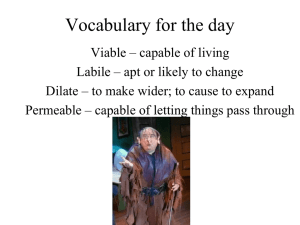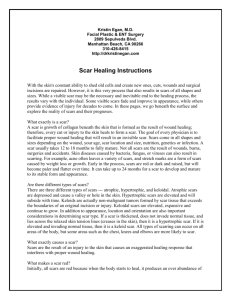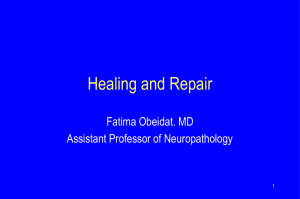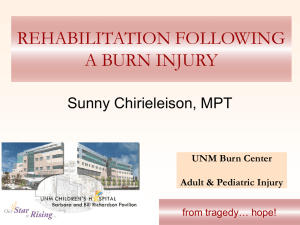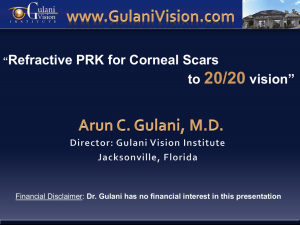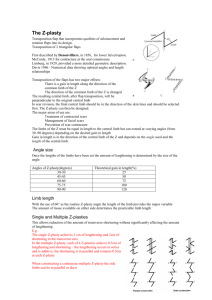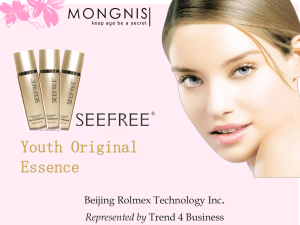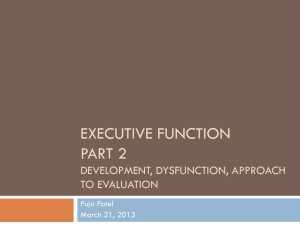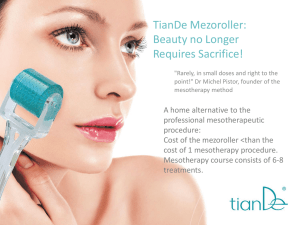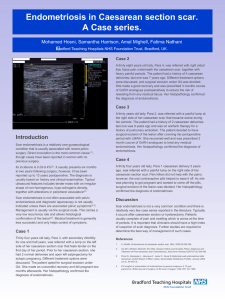Pedal Scars
advertisement
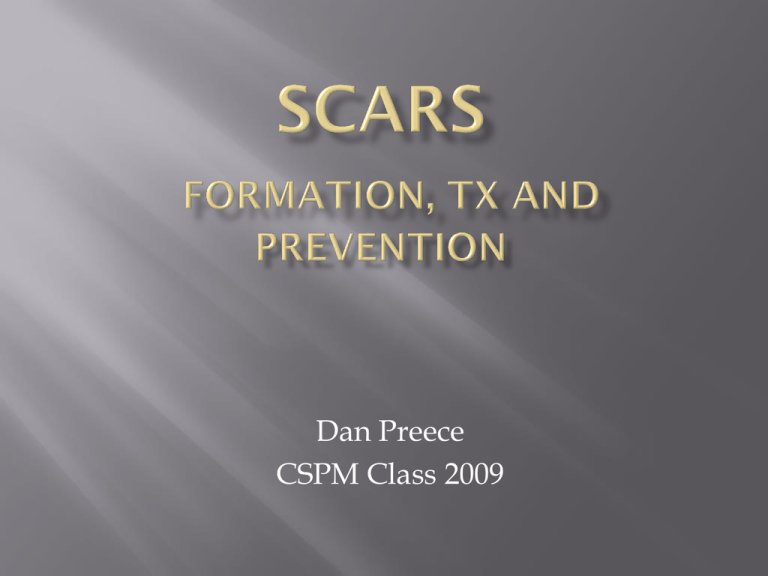
Dan Preece CSPM Class 2009 Fig. 1 African Americans Areas of high hair follicle density Wounds crossing a joint(s). Wounds on the ears, neck, jaw, presternal chest, shoulders, and upper back. Normal Scar Formation: Hypertrophic Scar: Enlarged/elevated scar within wound margins. Keloid: Scar extending beyond wound margins. Elevated: Wound closure under tension Inadequate apposition of edges Full-thickness grafts (oversized) Depressed scar: Deep shave biopsy Electrodesiccation/curettage Deficient wound eversion Prior hematoma or infection Widened scars: Wound closed under tension Long linear scar: Laceration, Poor preoperative planning Contracted/webbed: Traverse concavities Correct incision placement goals: Avoid neurovascular structures Avoid areas of shoe pressure or WB pressure Follow RSTL’s Achieve adequate exposure to the surgical target. Borges and Alexander (8) described lines similar to those described by Cox, but termed the former set of lines RSTLs. RSTLs are formed by the dynamic action of muscles creating tension and laxity across the skin surface. To find the RSTLs, one simply relaxes the skin in an area by passive manipulation at a joint or by muscle movement. In areas where motion is minimal, the RSTLs may be found by using the pinch test (7) Incisions perpendicular to RSTLs will tend to gap. - - - Curvilinear incisions over joints. Contracting scar force will not be perpendicular to axis of joint. Avoid skiving incision edges. Leads to devascularization. Long single passes with knife instead of multiple short passes. If WB surface is unavoidable, non-WB post-op period can help reduce scar formation. - Use a skin marker. "Measure twice, cut once“. - Use “cross hatches”, avoids creating redundant skin. (7) “Reapproximate not strangulate" the wound edges. Tight sutures can create areas of localized ischemia. Suture deep tissues or undermine skin edges to help with reapproximation. Choose suture material carefully. Use nonabsorbable monofilament to avoid suture reactivity and harboring of bacteria. Consider fibrin glues (has been shown to have the same strength at 2 weeks post op as suture). Currently available therapies Proposed Mechanism of Action Corticosteroids (injection) Inhibition of inflammatory mediators. Inhibition of fibroblast proliferation. Inhibition of collagen synthesis. Enhanced collagen degradation. Inhibition of TGF-1 and TGF 5-Fluorouracil Inhibition of fibroblast proliferation Inhibition of TGF-1–induced collagen synthesis Bleomycin (injection) Inhibition of collagen synthesis Inhibition of lysyl-oxidase or TGF (2) CurrentlyAvailable Therapies Proposed Mechanism of Action Laser therapy Selective photothermolysis of scar vascular supply, inhibition of TGF-, fibroblast proliferation, and collagen type III deposition. Silicone gel sheeting Hydration, inhibition of collagen deposition down-regulation of TGF Pressure therapy Reduced oxygen tension ¡ inhibition of fibroblast proliferation and collagen synthesis, and increase in collagen lysis. Radiation Inhibition of fibroblast proliferation and neovascular bud formation Cryotherapy Decreases collagen synthesis, mechanical scar tissue destruction, scar neovascularization. (2) Surgical Treatment Strategies: Excision with linear closure Excision with split- or full-thickness skin grafting Z-plasty or W-plasty If all other options fail, excision followed by flap coverage, possibly incorporating balloon skin expansion. Surgical excision as a sole treatment of keloids/hypertrophic scars has a very high recurrence rate, between 45 and 100 percent. (1) Excision followed by radiation therapy has a 16 to 27 percent recurrence rate. (9) The radiation treatment is carried out in 200-rad increments daily for 5 days and is ideally begun on the day of surgery. (Above) A 35-year-old African American man with a history of a large recurrent irregular keloid. Had previously undergone two surgical excisions followed by corticosteroid injections with recurrence of the keloid. (Below) Appearance 9 months after treatment with surgical resection and immediate postoperative radiation treatment. Tissue expansion: Allows revision of large scars in a rapid, twostage fashion. 1.The expander is placed in the subcutaneous space and sequentially filled with saline. 2. The expanded skin is used to replace the excised scar. The skin may be reexpanded as necessary. (10) Studies of fetal wound healing suggest that a high level of inflammation may promote scar formation rather than enhancing wound healing. (6) Up-regulation of TGF-1 and TGF-2 can lead to excessive scarring as demonstrated in numerous animal models. Techniques for neutralizing these substances are being investigated. (4) There are several ongoing Phase II clinical trials evaluating Juvista, human recombinant TGF-3 that helps to decrease collagen synthesis(5) Topical application of a selective COX-2 inhibitor immediately after wounding resulted in a statistically significant reduction in local neutrophils, prostaglandin E2 levels, TGF-1, collagen deposition, and scar formation in a mouse study. (3) 1. Berman, B., and Bieley, H. C. Adjunct therapies to surgical management of keloids. Dermatol. Surg. 22: 126, 1996. 2. Richard G. Reish, M.D. Elof Eriksson, M.D., Ph.D.Scars: A Review of Emerging and Currently Available Therapies. Plast. Reconstr. Surg. 122: 1068, 2008.) 3. Wilgus, T. A., Vodovotz, Y., Vittadini, E., Clubbs, E. A., and Oberyszyn, T. M. Reduction of scar formation in full-thickness wounds with topical celecoxib treatment. Wound Repair Regen. 11: 25, 2003. 4. Wang, X., Smith, P., Pu, L. L., Kim, Y. J., Ko, F., and Robson, M. C. Exogenous transforming growth factor beta 2 modulates collagen I and collagen III synthesis in proliferative scar xenografts in nude rats. J. Surg. Res. 87: 194, 1999. 5. Lin, R. Y., Sullivan, K. M., Argenta, P. A., Meuli, M., Lorenz, H. P., and Adzick, N. S. Exogenous transforming growth factor-beta amplifies its own expression and induces scar formation in a model of human fetal skin repair. Ann. Surg. 222: 146, 1995. 6. Mast, B. A., Diegelmann, R. F., Krummel, T. M., and Cohen, I. K. Scarless wound healing in the mammalian fetus. Surg. Gynecol. Obstet. 174: 441, 1992. 7. Storm T, Lee M. Plastic and Reconstructive Surgery. McGlamry’s Textbook of Foot and Ankle Surgery. 2001. Ch 44, pg 1487-1583. 8. Borges AF, Alexander JE. Relaxed skin tension lines, Z-plasties on scars, and fusiform excision of lesions. Br J Plan Surg 1962;15: 242-254. 9. Ragoowansi, R., Cornes, P. G., Moss, A. L., and Glees, J. P. Treatment of keloids by surgical excision and immediate postoperative single-fraction radiotherapy. Plast. Reconstr. Surg. 111: 1853, 2003. 10. Coughlin, Man, Saltzman. Surgery of the Foot and Ankle. Ch 34, pg 1903-05. Figures: 1. Reish, RG and Eriksson E. Scars: a review of emerging and currently available therapies. Plast Reconstr Surg. 2008 Oct;122(4):1068-78.
